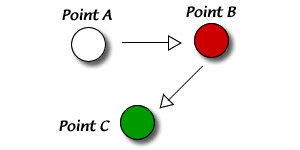![]()
![]()
![]()

![]()
![]()
![]()
|
"Master One Of The Most Important Fundamentals Of Your Fighting Skills - Your Feet!" From: Jason Stanley, 3rd Dan Shitoryu Many new students have difficulty using their feet. I'm not referring to kicking in this article, I'm talking about footwork, positioning and dynamic movement. This is one thing that is difficult to master. Until you have it "under your belt" so to speak, you don't use your feet in the correct way and will be left frustrated and disheartened. Footwork is one of the foundations of karate. It doesn't matter if it's in self defense, kihon, kata or kumite - footwork is required in all four aspects of your training. If you're willing to learn and want to improve then I'm about to show you exactly how easy it is to move once you understand and know how to apply these concepts. Before I forget, please subscribe to the KarateTips newsletter - it's packed full of great tips, articles and information to help you improve your fighting, kata and teaching skills... This might be basic revision for some of us, but for most it is the realization of an important concept. First let's consider why footwork is important...
It's important to have good footwork to take you from point A to point B so you maximize your opportunities...
Good footwork also gets you back from point B to point A, or from point B to point C, where point C is a different position to that in which you started.
Before you can move effectively, you must be on the balls of your feet as this is the part of your foot that is responsible for your balance and dynamic movement. Don't believe me? Stand in your forward stance and put all your weight on your heels by lifting your toes and balls of your feet off the floor - try to move around. The most effective way to move is by sliding rather than stepping. Although there are certainly times when you need to step rather than slide, please remember the following key point....
I have listed the following 4 movements in order from fastest to slowest:
So if you're only good at stepping, you're going to be in trouble when you come across someone who knows how to slide dynamically! I'm not going to teach you how to step, as different styles place emphasis on different aspects of stepping, plus your sensei can show you that. Instead I'd like to break down the 4 basic sliding movements and discuss how to perform each. Moving forward The key to this is that you are transferring very little weight to your rear leg. With practice you'll know when you do this technique correctly. But an easy way to test your forward slide is by by trying the following exercise. Stand in your forward stance and pick up your front foot 2 inches without transferring your weight to your rear leg. What happens? You fall forward because you have around 50% of your weight over your front foot which is no longer on the ground and you also have tension in your stance that causes you to move forward. Now when you want to drive forward (instead of just falling), pick up your foot slightly and push with your rear leg before your front foot hits the floor. Viola! You've just slid 12-24 inches depending on how hard you pushed.
Moving backward Moving sideways Of course moving right is the exact opposite of moving left. First pick up your rear (right) leg a fraction and drive right with your left (front) leg. Other directions The
"Double Shuffle" This is exceptionally handy in a sparring situation when you throw a front hand/rear hand combination. Throw the first punch on the first shuffle and the reverse punch on the second shuffle. Be sure to keep your hands up! You'll find that you "cross the gap" between you and your opponent quickly and easily. For advanced users.... Make your first shuffle forward, but before your front foot touches the ground, drive as hard as you can with your rear leg a second time. It's kind of like a double shuffle but your front foot doesn't touch down between the first and second shuffle as it does with the double shuffle. You can apply this same concept to moving backwards when you have to get out of range very quickly. Lift your rear foot and drive with your front leg backwards, but before your rear foot touches down, drive again with your front leg in the backwards direction. In closing here are some important points to remember...
|
![]()
![]()
![]()
![]()
![]()
![]()
![]()
![]()
![]()
ęCopyright 2025 Kofukan Karate Master. All rights reserved.
![]()
